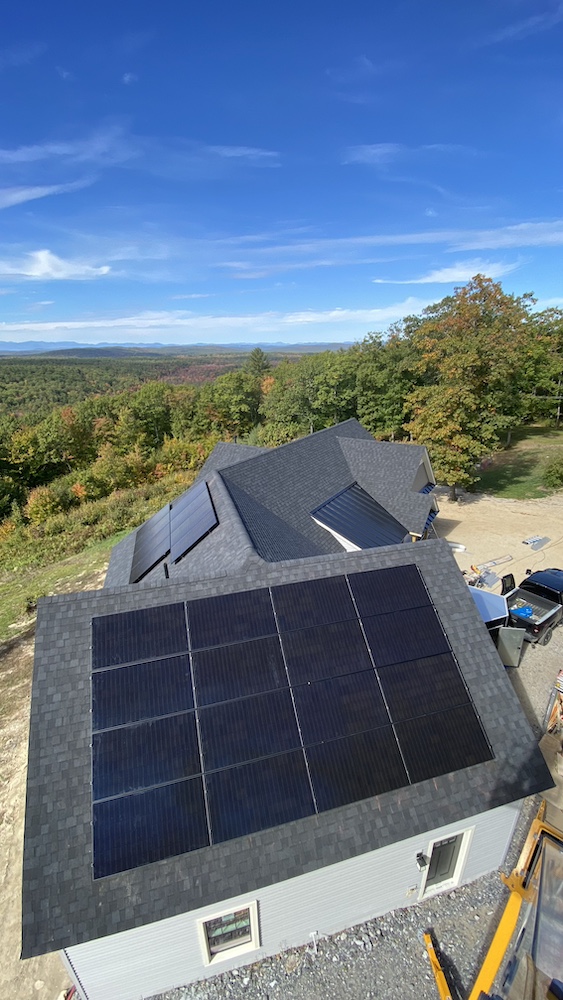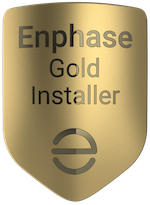
Most of our customers install grid-tied PV systems. Grid-tied systems allow for seamless integration with your utilities electricity supply. This allows you to net meter your energy production, ensuring that all of the electricity your system produces offsets your usage. For clients who desire a battery backup system, Cleantap Energy offers grid-tied systems with battery backup.
- Photovoltaic panels convert the solar radiation that strikes them into low-voltage DC electricity.
- That DC electricity travels to an inverter where it is converted into the AC electricity used by household outlets and appliances.
- From the inverter, the AC electricity heads to your electrical panel, where it is distributed throughout your house as needed.
During the daytime when your system is producing power, any electrical demands in your home are satisfied by the electricity that you produce first. If your home’s demand is greater than the amount of electricity being produced on the roof (such as during the evening or inclement weather), the electric utility, or grid, will provide the rest. If, on the other hand, your system’s electrical production is greater than your home’s electrical demand, the excess power is sent out on the grid, building up a credit.
At the end of your billing period, CMP will subtract the energy you put out on the grid from the energy that you imported from the grid and charge you for the difference. This is called net metering.
Net metering is a purchasing agreement between you and the electric utility (CMP, for example) that allows you to receive credit for excess energy that your solar array may produce. Net metering is a simple concept; power created from your solar system is connected to the electric grid and credited in real-time. Any excess power created by the solar system that you are not using, at that moment, is fed back into the power grid. As this excess power is ‘back-fed’, your meter operates in reverse. CMP subtracts the excess kW hours that you produce from the kW hours that you get from the grid and only charges for only the “net” electricity that you receive from the grid.
Typically, energy credits that are built up during the day are “traded in” at night. Not only are credits built up and “cashed in” on a daily basis, but credits are accrued and credited on a rolling 12-month period, allowing greater summertime electricity production to offset greater wintertime use.
South facing is best, but solar panels installed facing south-east or south-west can generate a very high percentage (>90%) of energy as compared to a south facing solar array.
No. There are other options such as ground mount or wall mounted awning systems. Mounting on a garage, barn, or outbuilding is also an option.
During our site evaluation, we will determine how much of your roof is shaded throughout the year. We can factor this into your estimated electricity production.
We assess your roof’s condition as part of our site survey. If we determine that your roof needs replacement, we can refer you to a trusted roofing contractor.
Grid-tied PV systems do not require batteries. Cleantap Energy does offer a grid-tied battery backup system.
Most grid-tied systems are designed to shut off automatically during power outages when the grid goes down. When power returns, your system will restart automatically. For customers with generators, we design a manual or automatic PV system shut-off based on your generator type. For customers with a keen interest in investing in a battery-based PV system, we can design and install a grid-tied battery backup that will allow them to power certain parts of their home during a power outage.
All of the solar panels that we install have power output warrantied for 25+ years (at 86% of the original power output.) The lifespan of a PV array is expected to be greater than 30 years. Inverter warranties range between 10 and 25 years.
Grid-tied solar electric systems require very little maintenance. Our grid-tied installations include system monitoring, which provides output information and alerts in case there is a problem.
Typical residential systems typically take 3 to 5 days to install. Ground mount systems and larger systems can take longer. We usually schedule our installations on a first-come, first-serve basis;
During our free site evaluation, we will work with you to determine what size system will meet your needs.
Your system’s cost is determined by three factors: current electrical usage, the percentage of your usage that you wish to offset, and your budget.
Energy conservation and renewable energy generation add value to a home. National surveys have shown that Solar adds 8-12% to a home’s value.
The Residential Clean Energy Credit, also known as the Investment Tax Credit (ITC), is a tax incentive worth 30% gross solar system cost. Solar photovoltaic systems qualify for a 30% federal tax credit thru 2032. The only requirements are that:
- You own the system by purchasing your solar via cash or a solar loan (lease or PPA financing cannot claim the tax credit)
- You have an income tax liability, which is what this incentive reduces Note, if your 30% tax credit is $6,000 total, and you only have $5,000 in personal income taxes one year, you can roll over the remaining $1,000 to next year’s income taxes.
Cleantap Energy offer loans through Sungage and Lightstream. Many of our clients also finance their systems with home equity loans or with home refinancing.
Solar is cleaner and less expensive than power from the utility company. It is a smart financial investment because you will save money on electrical costs for years to come and increase your home value. Our customers who purchase their system typically see a strong return on investment (ROI) and expect to recoup their solar system investment within 7-12 years. After the system has paid for itself, it continues to pay by providing free electricity. As electrical utility rates rise, your solar investment becomes even more valuable and your property’s value increases as well!
Wind Power Solutions
Morbi vehicula fermentum volutpat. Aenean lacinia vel odio et accumsan. Maecenas condimentum odio libero, ut rhoncus purus tempus sit amet, aliquet feugiat erat.
- Advantages
- Costs & Installation
Nullam sodales lobortis tellus. Ut sed suscipit ligula. Sed sed ex vestibulum, posuere mauris vitae, blandit risus. Vestibulum ac ex augue quisque at mi enim.
Podcasting operational change management inside of workflows to establish a framework. Taking seamless key performance indicators offline to maximise.
Aenean nec dui vel sem dignissim bibendum. Suspendisse sed erat at nulla varius tincidunt. In quam neque, iaculis sed felis ut.

